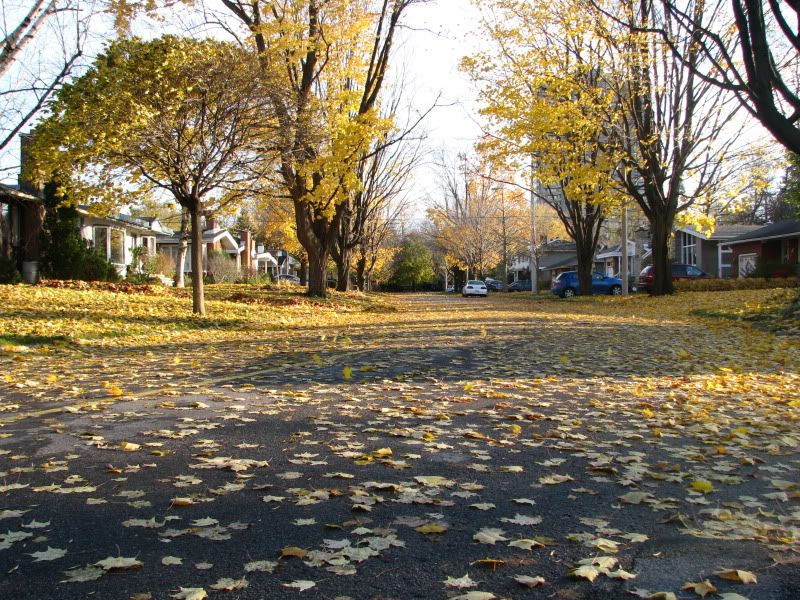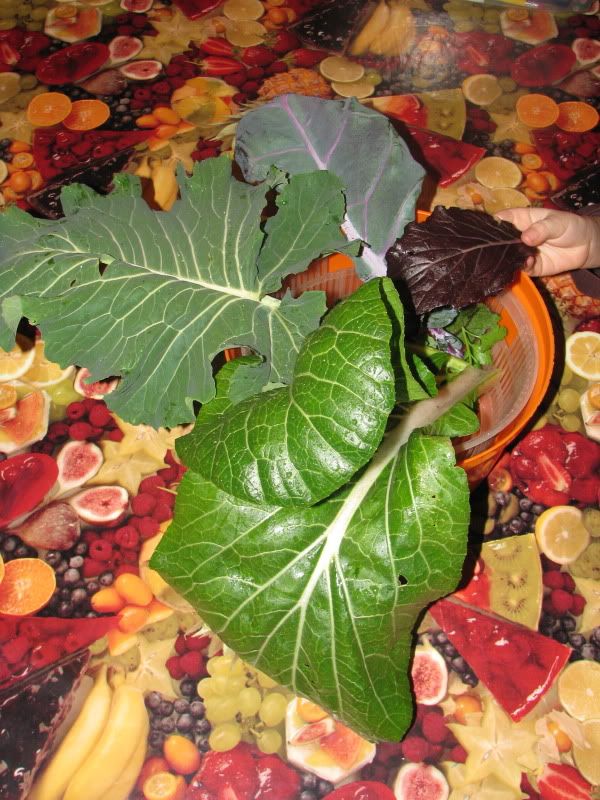When I think autumn, I think leaves. Crunching along beside curbs cluttered with the bounty of fall litter. These gold, orange, brown and red riches fall in the urban forest just like they do in the wild but instead of enriching the soil, they are carefully removed, bagged and placed at the curb for pick up.

Leaves litter a suburban street.
Now don't get me wrong, I love bagged leaves. When I get a chance, I haul them back to my property where they are transformed into leaf mulch for perennial beds, path material, compost browns, insulation for tender crops and leaf mould. However, I feel a bit guilty taking from others who have not learned to appreciate this harvest time bounty. Not only are they missing out on a great soil conditioner, but it is easier on the back too since as an adult, fall memories contain a fair amount of raking.
My leaves are left if they flitter to a mulched path, perennial bed or beneath the hedge where they act as weed surpressers. Since my veggie patch is made of raised beds, leaves naturally settle on the pathes, locking teeth and becoming an effective mulch. Those that litter the lawn are mulched by our lawn mower and either left there or collected in the lawn mower bag. This rich mixture of grass clippings and leaves is then spread on the perennial beds. What remains to rake is only our patio stones and the rock path. Any extra leaves are left in a pile by the composter to add as part of my 'brown' layer, or to decay into leaf mould, a wonderful topdressing for the garden. Of course, if I'm making a new garden bed, the leaves are part of the organic layer I place on top of the sod.
Big Brash Brassica

But this is not the end to my leaf harvest. Brassicas make up a big portion of my fall garden as they are cold tolerant and tend to grow better in the cool, fall weather. Here my eldest daughter (her hand for scale at the top right) shows you some supersized greens: leaf broccoli, kale, chinese cabbage and a baby mustard leaf. They were whizzed up and added to a pancake recipe to make a savory base for curry. The kids loved these pancakes which did not taste that green (a plus for them).
As December begins, leaf harvest is almost at an end. The trees stand naked and the brassicas are braving the bracing wind. All is waiting for snow.
***
Also...
Seeds, glorious seeds. I'm pleased to say that I have had lots of requests for seeds (see side bar for seed list) and another batch of mailings will be going out this week. They may take a bit longer in this Xmas rush but hopefully they'll be there shortly.
Wondering where part three of the Soil Scars and Dressing your Dirt went too? I felt like a leafy interlude but Part III on specific veggies will be here next week, promise.

7 comments:
Hear hear! My neighbour has a maple tree out front, while we only have a flowering quince bush, so I like to try to grab those maple leaves with our mulching leaf vacuum (thankfully lots of them come over to our lawn too) and add them to all our beds. But in the back we have a giant oak tree, and those thick waxy leaves do not like to break up, so I rake those and put them out for pick up. I've also heard oak leaves can unbalance soil. Is that true? Or is there a way I could compost them (there are SO many).
Most of the leaves I use are oak leaves from two red oaks, one in front and one in back. They may acidify the soil over time but my soil has retained a nuetral pH for as long as I have been testing. These kind of leaves are especially good for mulching pathes but break down pretty quickly if you run them through a mulcher. They can mat up if not mixed with other things in the compost, I've noticed. Composting them should help create a more nuetral balance as it will be broken down with other things.
Love leaves :)
Great post! It all goes back to that "one (wo)mans trash is another ones treasure!" thing.
We too collect leaves locally but I don't generally use them for mulch, instead I feed them to the worm heard or cut them with thermophilic compost to release the nutrients faster.
Oak can acidify and I always go easy with it in the worm bins, but it's nothing a bit of lime can't correct. I have noticed that maple seems to be the preffered foodstock of my worm heard for some reason or another and they will devour those before they devour any others.
wow is that your countertops? so colorful! i'm growing some kale also...
Em: No, it's a tablecloth but it would make a fun countertop!
Thanks for mentioning my Roots book. I appreciate it very much.
You're more than welcome Robert. I found it fascinating and informative.
Post a Comment